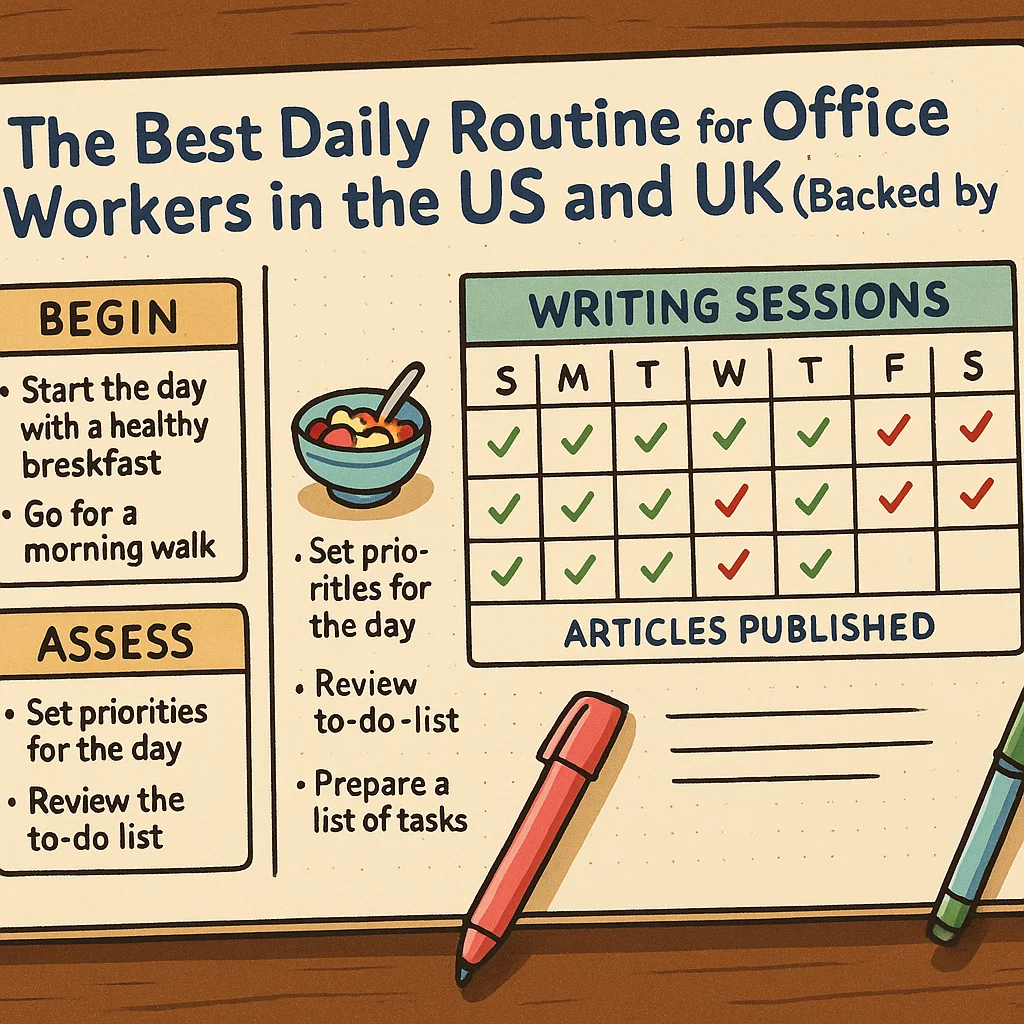Introduction: Why Your Daily Routine Matters
Ever feel like no matter how hard you work, your productivity plateaus by mid-afternoon? You’re not alone. Studies show that only 26% of office workers feel productive for their entire workday, with energy dips, distractions, and poor time management being major culprits.
The secret? A science-backed daily routine that aligns with your body’s natural rhythms. Whether you’re in the US or UK, optimizing your schedule can help you work smarter—not harder.
In this guide, we’ll break down the best productivity schedule for office workers, backed by neuroscience, chronobiology, and workplace efficiency research.
The Science Behind an Optimal Work Routine
Before diving into the ideal schedule, let’s understand why timing matters:
- Circadian Rhythms: Your body has a natural 24-hour cycle affecting energy, focus, and sleep.
- Ultradian Rhythms: 90-120 minute cycles where focus peaks and dips.
- The 80/20 Rule (Pareto Principle): 20% of your efforts drive 80% of results.
Research from Harvard Business Review and The British Psychological Society confirms that structured routines improve productivity by 34% and reduce burnout.

The Best Daily Routine for Office Workers (US & UK)
Here’s a science-backed productivity schedule tailored for office workers:
1. Morning (6:30 AM – 9:00 AM): The Golden Hours
✅ 6:30 AM – Wake Up & Hydrate
- Drink water to rehydrate after sleep (studies show dehydration reduces cognitive performance).
- Avoid checking emails immediately—this spikes cortisol (stress hormone).
✅ 6:45 AM – Light Exercise or Stretching
- A 10-minute walk or yoga session boosts blood flow and alertness (NIH study).
✅ 7:15 AM – Healthy Breakfast
- High-protein meals (eggs, Greek yogurt) sustain energy better than carbs.
✅ 8:00 AM – Deep Work Session
- Your brain is sharpest in the morning—tackle complex tasks first (MIT research).
2. Mid-Morning (9:00 AM – 12:00 PM): Peak Focus Time
✅ 9:00 AM – Prioritize Top 3 Tasks
- Use the Eisenhower Matrix to focus on urgent & important tasks.
✅ 10:30 AM – Short Break (Pomodoro Technique)
- After 90 minutes, take a 5-10 min break to recharge (University of Illinois study).
✅ 11:30 AM – Meetings (If Necessary)
- Schedule meetings before lunch—post-lunch drowsiness lowers engagement.
3. Afternoon (12:00 PM – 3:00 PM): Combat the Post-Lunch Slump
✅ 12:00 PM – Lunch & Walk
- A 20-minute walk post-lunch improves digestion and mental clarity (Mayo Clinic).
✅ 1:30 PM – Low-Intensity Tasks
- Save emails, admin work, or brainstorming for this lower-energy window.
✅ 2:30 PM – Caffeine Boost (If Needed)
- The best time for coffee is between 1:30 PM – 3:00 PM (sleep science).
4. Late Afternoon (3:00 PM – 6:00 PM): Winding Down
✅ 3:00 PM – Creative Work
- Right-brain activities (design, writing) thrive in the late afternoon (BBC Worklife).
✅ 4:30 PM – Plan Tomorrow’s Tasks
- Writing a to-do list before leaving reduces next-day stress (Baylor University).
✅ 5:30 PM – Digital Detox
- Stop work-related emails to improve work-life balance (Stanford study).
5. Evening (6:00 PM – 10:00 PM): Recovery & Sleep Prep
✅ 6:30 PM – Exercise or Relaxation
- Light exercise (walking, stretching) aids recovery.
✅ 8:00 PM – Screen-Free Time
- Blue light from screens disrupts melatonin (sleep hormone).
✅ 10:00 PM – Sleep
- Aim for 7-9 hours—consistent sleep improves next-day performance (Sleep Foundation).
Key Differences: US vs. UK Work Schedules
| Factor | US Office Workers | UK Office Workers |
|---|---|---|
| Typical Start Time | 8:00 AM – 9:00 AM | 8:30 AM – 9:30 AM |
| Lunch Break | 30 min – 1 hour | 45 min – 1.5 hours |
| Work-Life Balance | More overtime | Stricter work-hour laws |
| Commute Impact | Longer drives (avg. 27 min) | More public transport use |
Pro Tip: UK workers benefit from flexible hours, while US workers should enforce stricter boundaries to prevent burnout.
Bonus: Tools to Optimize Your Routine
- Focus Apps: Forest (for deep work), Toggl (time tracking)
- Sleep Aids: Sleep Cycle (smart alarms), f.lux (blue light filter)
- Meal Planning: MyFitnessPal (nutrition tracking)
Final Thoughts: Small Changes, Big Results
A well-structured daily routine isn’t about working more—it’s about working smarter. By aligning your schedule with natural energy cycles, you’ll boost productivity, reduce stress, and enjoy a healthier work-life balance.
What’s your biggest productivity challenge? Share in the comments below!


